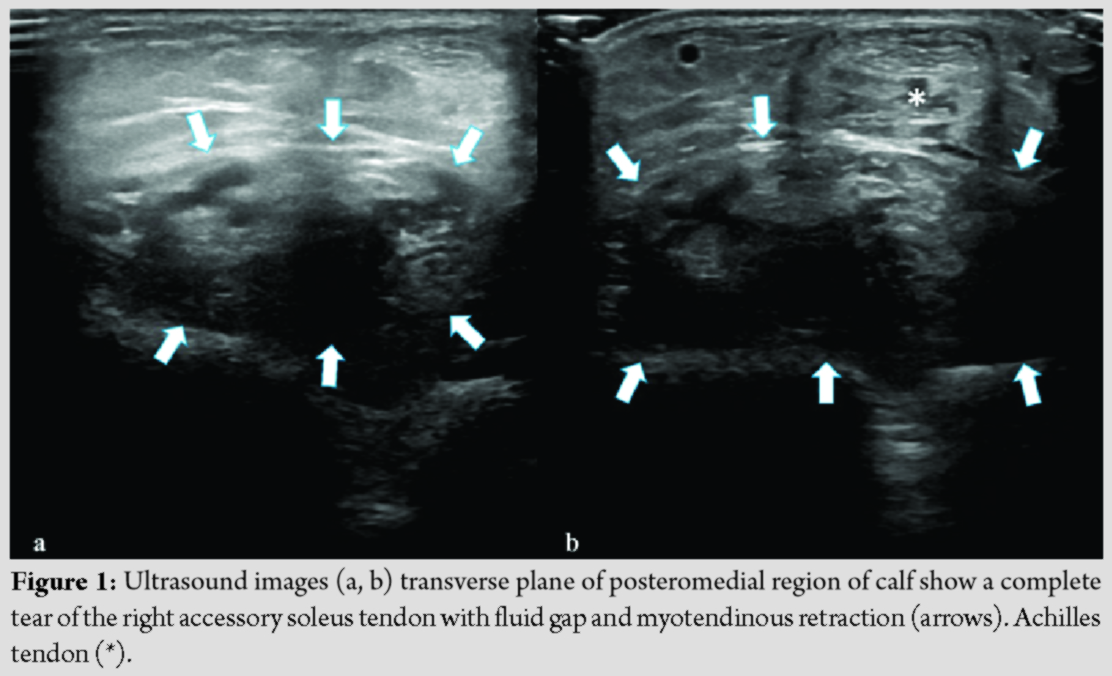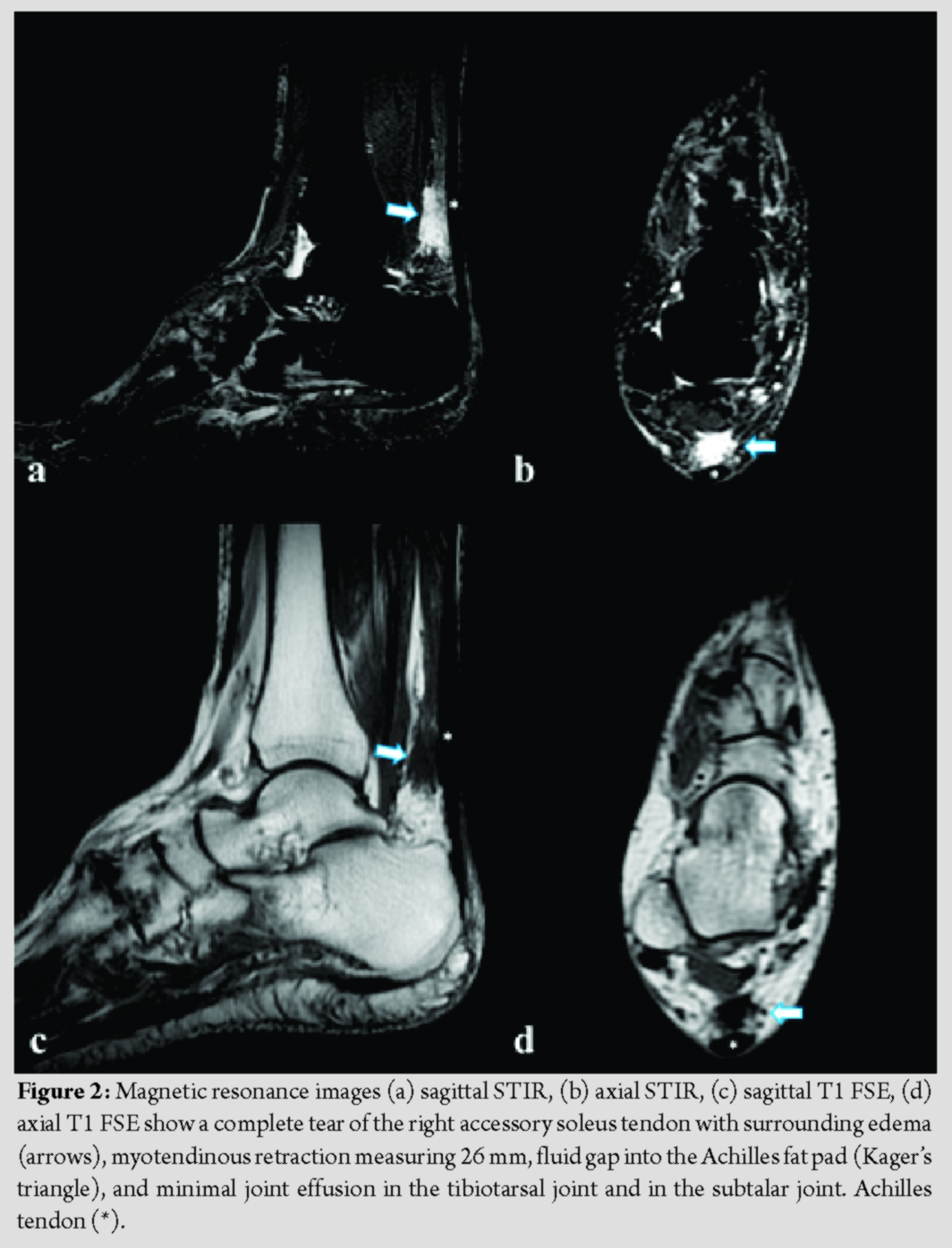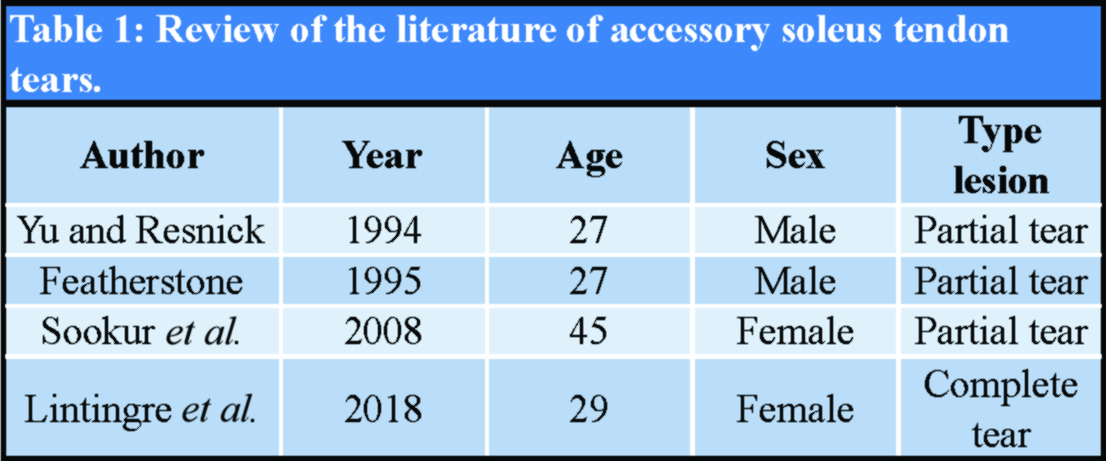[box type=”bio”] Learning Point of the Article: [/box]
To review accessory soleus muscle imaging features to raise awareness of its anatomy, function, and pathology.
Case Report | Volume 10 | Issue 2 | JOCR March – April 2020 | Page 84-87 | I Simonetti, F Di Pietto, M Zappia, P Trovato, F Verde, V Chianca. DOI: 10.13107/jocr.2020.v10.i02.1710
Authors: I Simonetti[1], F Di Pietto[2], M Zappia[3], P Trovato[1], F Verde[1], V Chianca[4]
[1]Department of Advanced Biomedical Sciences, Università Degli Studi Federico II – Via Pansini5, 80131, Napoli, Italy,
[2]Department of Radiology –Pineta Grande Hospital, Castel Volturno, CE, Italy,
[3]Department Life and Health “V. Tiberio,” University of Molise, Via Francesco De Sanctis 1, Campobasso86100, Italy,
[4]Unit of Diagnostic and Interventional Radiology – I.R.C.C.S. Istituto Ortopedico Galeazzi, Milano.
Address of Correspondence:
Dr. Piero Trovato,
Department of Advanced Biomedical Sciences, Università DegliStudi Federico II – Via Pansini5, 80131, Napoli, Italy.
E-mail: piero_trovato@hotmail.it
Abstract
Introduction: The accessory soleus muscle (also known as the supernumerary soleus or soleus secundus) is an uncommon congenital anatomical. The presence of this muscle is generally asymptomatic. In cases of symptomatic accessory soleus muscle, it manifests with painful swelling of the posteromedial region of the ankle. To the best of our knowledge, partial or complete accessory soleus tendon tears were reported in literature in only three cases; all of them were diagnosed with magnetic resonance imaging (MRI) examination while only one was diagnosed with both ultrasound (US) and MRI.
Case Report: We presented a case of a 63-year-old Caucasian woman presented to our emergency department with severe pain in the posteromedial region of her right ankle. US and MRI of the calf and ankle were performed and a complete tear of the right accessory soleus tendon with fluid gap and myotendinous retraction was diagnosed.
Conclusion: An accessory soleus muscle partial or complete tears are very uncommon injuries. This condition can mimic many other pathologies, and therefore, radiologists should know the physiological and pathological imaging findings for a correct interpretation of ankle injuries, avoiding misinterpretations.
Keywords: Accessory soleus muscle, ankle, calf, muscle injury, magnetic resonance imaging, injuries ultrasound.
Introduction
The accessory soleus muscle (also known as the supernumerary soleus or soleus secundus) is an uncommon congenital anatomical with a prevalence ranging from 0.7% to 5.5% [1]. The presence of this muscle is generally asymptomatic, but it can present with a strong pain in the posterior aspect of the calf, a well-known pathological condition called“tennis leg” [2]. In literature, few studies have reported muscle or tendon tears of the accessory soleus [3]. To the best of our knowledge, partial or complete accessory soleus tendon tears were reported in literature in only three cases; all of them were diagnosed with magnetic resonance imaging (MRI) examination while only one was diagnosed with both ultrasound (US) and MRI [3, 4, 5, 6]. We report a case of an isolated complete tear of the accessory soleus tendon with myotendinous retraction in a 63-year-old woman diagnosed with US examination and confirmed with MRI.
Case Report
A 63-year-old Caucasian woman presented to our emergency department with severe pain in the posteromedial region of her right ankle, caused by an adduction force on the supinated foot during walking. The patient was a housewife who did not usually practice sports activities. She denied previous injuries and surgery on her ankle and other districts.
At clinical examination, the ankle showed swelling without deformity, bony prominences, ecchymoses, or continuous solutions of the skin. The ankle pain increased during palpation, dorsiflexion, and rotation of the foot.
X-ray of the right ankle did not show osteoarticular lesions, osseous abnormalities, periarticular soft-tissue calcifications, or joint effusion.
US evaluation of the calf and ankle was subsequently performed showing normal findings of the Achilles tendon, soleus muscle, plantaris tendon, and both medial and lateral heads of the gastrocnemius; color Doppler US excluded deep vein thrombosis. However, examination of the posteromedial region showed fluid gap with a myotendinous retraction suspicious for an accessory soleus tear muscles with a complete tear of tendon with a myotendinous retraction (Fig. 1). MRI confirmed the diagnosis and demonstrated complete tear of the right accessory soleus tendon with surrounding edema, myotendinous retraction measuring 26 mm, fluid gap into the Achilles fat pad (Kager’s triangle), and minimal joint effusion in the tibiotarsal joint and in the subtalar joint (Fig. 2). No other abnormalities were detected on MRI.
A conservative treatment approach was adopted including orthotics and reduction of activity. Moreover, the patient underwent physical therapy consisting of stretching exercises. This conservative rehabilitation program lasted 1 month, after that, the patient regained a complete functional status confirmed at follow-up US which showed decreased edema as well as resolving myotendinous retraction.
Discussion
The prevalence of the accessory soleus muscle is about 0.7–5.5% in cadaveric studies and 3% in reported imaging studies on patients [7]. Bilateral accessory soleus muscle is more frequent in females population, while males are more prone to unilateral presentation [8]. The accessory soleus is innervated by the posterior tibial nerve, and the posterior tibial artery gives blood supply [6]. In most patients, this condition is asymptomatic and it is an incidental finding during surgery or imaging examinations [7]. Therefore, this rare symptomatic condition most commonly affects males during the 2nd and 3rd decades, due to the increase in muscle mass [9]. The embryological origin of both the soleus and accessory soleus muscles is due to a single anlage [10]. The potential development mechanism of supernumerary musculature is suggested to be cause by the early splitting of this anlage [10]. Five types of accessory soleus muscle have been described, based on the different distal insertional sites [11]. This insertion may be the Achilles tendon, the upper surface of the calcaneus with a fleshy muscular insertion, the superior surface of the calcaneus with a tendinous insertion, the medial aspect of the calcaneus with a fleshy muscular insertion, and finally, the medial aspect of the calcaneus with a tendinous insertion [11]. In general, it manifests clinically as an asymptomatic soft-tissue mass in the posteromedial region of the ankle [6]. In most cases of symptomatic accessory soleus muscle reported in the literature, it manifests with painful swelling of the posteromedial region of the ankle during chronic exertion that usually disappears during post-exercise recovery, with a higher incidence in athletes [6]. The main causes of pain are excessive pressure on the nerve innervating the accessory soleus muscle, ischemic blood supply, compression of the tibial nerve by the accessory soleus muscle, and an increased intrafascial pressure with the development of localized compartment syndrome [1]. US, computed tomography (CT), and MRI examinations can accurately demonstrate accessory soleus muscles and help to differentiate them from other soft-tissue masses of the posteromedial region of the ankle such as lipoma, ganglion, hemangioma, sarcoma, and synovioma [6, 7]. However, X-ray shows an obliteration of the Kager’s triangle by soft-tissue mass and allows to exclude bony pathologies [6, 7]. US allows an excellent evaluation of the superficial soft tissues including the muscular units and the myotendinous junctions [12]; it can also exclude a venous thrombosis with color Doppler US [13]. Moreover, US compared with MRI enables dynamic and comparative assessment of the clinical structures [13]. CT allows a panoramic evaluation showing the exact location of the accessory soleus muscle but does not show an accurate differentiation of this anatomic variant from other soft-tissue masses due to the low contrast resolution [7]. MRI is the gold standard for its excellent contrast resolution. It easily shows the insertion of the accessory soleus muscle and is able to differentiate it from other anatomical structures [6, 7.] The therapeutic management is based on the presence and the severity of symptoms [3]. No treatment is needed for asymptomatic patients [3, 7]. In patients with moderate symptoms, conservative treatment is generally indicated based on rest, nonsteroidal anti-inflammatory drugs, and physical therapy; in patients with severe pain, surgical approach, such as fasciotomy, tendon release, excision, or debulking, is required [3, 7]. Intramuscular injections of botulinum toxin type A are an additional treatment with good results [3, 7]. US represents a reliable tool for monitoring healing process in correlation to clinical findings of functional recovery, and as in our case, we suggest performing US coupled to clinical evaluation as investigation imaging method of choice after rehabilitation program as well as in the follow-up periods. Reports of complete tendon tear with a myotendinous retraction are extremely rare in the literature. To the best of our knowledge, previously, only four cases were reported. Yu and Resnick [4], Sookur et al. [6], and Featherstone [5] described a partial tear of accessory soleus muscles diagnosed with a MRI evaluation; Lintingre et al. [3] reported a complete rupture of the accessory soleus tendon with myotendinous retraction diagnosed with US scan and confirmed by MRI (Table 1).
Conclusion
An accessory soleus muscle partial or complete tears are very uncommon injuries [9]. When symptomatic, this condition mimics many other pathologies such as lesions of the soleus muscle, Achilles tendon, deep vein thrombosis, and compartmental syndromes. For these reasons, radiologists should know the physiological and pathological imaging findings for a correct interpretation of ankle injuries, avoiding misinterpretations.
Clinical Message
US examination is advisable for the evaluation of the patient with severe pain at the posterior aspect of the calf or ankle or in case of asymptomatic mass soft-tissue masses on the posteromedial region of the ankle.
References
1. Brodie JT, Dormans JP, Gregg J. Accessory soleus muscle. 4 cases report and review literature. Clin Orthop Related Res 1997;337:180-6.
2. Rossi R, Bonasia DE, Tron A, Ferro A, Castoldi F. Accessory soleus in the athletes: Literature review and case report of a massive muscle in a soccer player. Knee Surg Sports TraumatolArthrosc2009;17:990-5.
3. Lintingre PF, Pelé E, Poussange N, Pesquer L, Dallaudière B. Isolated rupture of the accessory soleus tendon: An original and confusing picture. Skeletal Radiol2018;47:1455-9.
4. Yu JS, Resnick D. MR imaging of the accessory soleus muscle appearance in six patients and a review of the literature. Skeletal Radiol1994;23:525-8.
5. Featherstone T. MRI diagnosis of accessory soleus muscle strain. Br J Sports Med 1995;29:277-8.
6. Sookur PA, Naraghi AM, Bleakney RR, Jalan R, Chan O, White LM. Accessory muscles: Anatomy, symptoms, and radiologic evaluation. Radiographics2008;28:481-99.
7. Jun Z, Dapeng H, Chuanyu Z, Shaohua W. MRI diagnosis of accessory soleus muscle: A case report and review of the literatures. Int J Foot Ankle2019;3:3-6.
8. Hatzantonis C, Agur A, Naraghi A, Gautier S, McKee N. Dissecting the accessory soleus muscle: A literature review, cadaveric study, and imaging study. Clin Anatomy2011;24:903-910.
9. Leswick DA, Chow V, Stoneham GW. Answer to case of the month #94: Accessory soleus muscle. Can Assoc Radiol J 2003;54:313-5.
10. Luck MD, Gordon AG, Blebea JS, Dalinka MK. High association between accessory soleus muscle and achillestendonopathy. Skeletal Radiol2008;37:1129-33.
11. Kendi TK, Erakar A, Oktay O, Yildiz HY, Saglik Y. Accessory soleus muscle. J Am Podiat Med Assoc 2004;94:587-9.
12. Sconfienza LM, Allen G, Bazzocchi A, Bignotti B, Chianca V, de Castro FF, et al.Clinical indications for musculoskeletal ultrasound updated in 2017 by European society of musculoskeletal radiology (ESSR) consensus. Eur Radiol2018;28:5338-51.
13. Simonetti I, Chianca V, Zappia M, Carfora M, Jannelli E, Di Pietto F. A rare case of Hoffa’s fat pad herniation in a young patient: Dynamic ultrasound and MRI diagnosis. J Biol RegulHomeost Agents2018;32:77-81.
 |
 |
 |
 |
 |
| Dr. I Simonetti | Dr. F Di Pietto | Dr. P Trovato | Dr. F Verde | Dr. V Chianca |
| How to Cite This Article: Simonetti I, Di Pietto F, Zappia M, Trovato P, Verde F, Chianca V. Ultrasoundand magnetic resonance imaging diagnosis of isolated tear of the accessory soleus tendon: A case report and review of the literatures. Journal of Orthopaedic Case Reports 2020 Mar-Apr;10(2): 84-87. |
[Full Text HTML] [Full Text PDF] [XML]
[rate_this_page]
Dear Reader, We are very excited about New Features in JOCR. Please do let us know what you think by Clicking on the Sliding “Feedback Form” button on the <<< left of the page or sending a mail to us at editor.jocr@gmail.com







